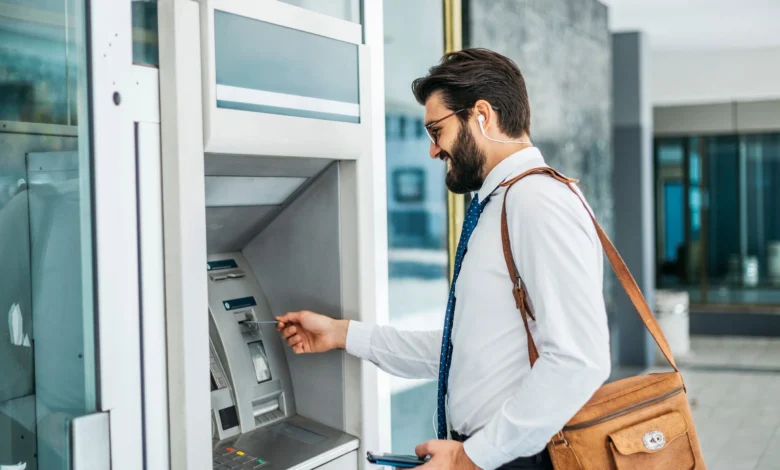How to Start an ATM Business in 5 Steps – ATM Depot

An ATM business involves owning and operating automated teller machines (ATMs) and placing them in various locations such as retail stores, restaurants, gas stations, and other high-traffic areas. The primary goal of an ATM business is to provide convenient cash access to customers while generating revenue through transaction fees charged for each ATM withdrawal or other services.
The core concept of an ATM business revolves around purchasing or leasing ATM machines and strategically placing them in locations with high foot traffic and demand for cash access. Business owners establish contracts with the location owners, often offering a percentage of the transaction fees or a flat monthly rent in exchange for hosting the ATM on their premises.
By providing ATM services, the business earns revenue primarily through surcharge fees charged to non-customers for each withdrawal, as well as interchange fees paid by the cardholder’s bank for processing the transaction. Additional revenue streams may include fees for balance inquiries, account transfers, or other services offered through the ATM interface.
History of ATMs
The concept of Automated Teller Machines (ATMs) dates back to the 1960s when the first modern ATM was introduced by Bankers Trust in New York City. However, the idea of self-service cash dispensers can be traced back even further to the late 19th century.
In 1939, Luther George Simian patented the first automated cash dispenser, which was designed to dispense a pre-determined amount of cash when a customer inserted a specially coded card. This concept, though innovative, was ahead of its time and never gained widespread adoption.
It wasn’t until the late 1960s that the first truly functional ATM was developed by John Shepherd-Barron, a British inventor, and entrepreneur. Inspired by the idea of self-service vending machines for cash, Shepherd-Barron designed and installed the world’s first modern ATM at a Barclays Bank branch in Enfield, London, in 1967.
The early ATMs were relatively simple machines that could only dispense cash and check account balances. However, as technology advanced, ATMs became more sophisticated, offering a wider range of banking services such as depositing checks, transferring funds, and paying bills.
ATMs
Throughout the 1970s and 1980s, ATMs proliferated rapidly across the United States and Europe, driven by the increasing demand for convenient banking services and the development of electronic funds transfer (EFT) networks. The introduction of magnetic stripe cards and personal identification numbers (PINs) also played a crucial role in enhancing the security and accessibility of ATMs.
In the 1990s and 2000s, ATMs continued to evolve, incorporating new features such as touchscreens, deposit automation, and advanced security measures like biometric authentication. The rise of Internet banking and mobile banking further integrated ATMs into the broader financial ecosystem, allowing customers to access their accounts and perform transactions seamlessly across multiple channels.
Today, ATMs are ubiquitous in most parts of the world, with millions of machines deployed by banks, independent ATM operators, and retail establishments. They have become an integral part of the modern banking infrastructure, providing convenient access to cash and a range of financial services to customers around the clock.
How Does an ATM Business Work?
An ATM business operates by placing automated teller machines (ATMs) in high-traffic locations and earning revenue from the fees charged for each transaction. The business model revolves around acquiring suitable locations, installing and maintaining the ATM machines, processing transactions securely, and generating income from the various fee structures.
The process typically begins with identifying and securing prime locations for ATM placement. Businesses often target areas with high foot traffic, such as shopping malls, gas stations, convenience stores, restaurants, and other retail establishments. Negotiating favorable contracts with property owners or businesses is crucial, as the location directly impacts the ATM’s usage and profitability.
Once a location is secured, the ATM business will purchase or lease the ATM machines from manufacturers or suppliers. These machines are then installed and connected to the appropriate financial networks, enabling them to process transactions from various bank cards and networks. Regular maintenance, cash replenishment, and technical support are essential to ensure the ATMs remain operational and compliant with industry standards.
The primary revenue stream for an ATM business comes from the transaction fees charged to users. These fees can vary depending on the type of transaction (withdrawal, balance inquiry, etc.), the network being used, and the fee structure set by the ATM business. Typically, a portion of the fee is retained by the ATM business, while the rest is distributed among the various parties involved, such as the card-issuing bank and the financial network.
ATM Business
Some ATM businesses also generate revenue through branding and advertising opportunities on the ATM screens or the machine itself. Additionally, they may offer additional services like check-cashing, money transfers, or bill payments, which can provide additional revenue streams.
Effective cash management is crucial in an ATM business, as it involves handling large amounts of cash regularly. Businesses must have robust security measures in place, including armored cash transportation, secure vaults, and strict cash handling procedures to mitigate the risks of theft or loss.
Overall, the ATM business model revolves around strategically placing ATMs in high-traffic areas, managing the machines efficiently, processing transactions securely, and earning revenue through various fee structures and additional services.
Benefits of Owning an ATM Business
Owning an ATM business can be a lucrative and rewarding venture, offering several advantages to entrepreneurs. One of the primary benefits is the potential for passive income. Once an ATM is installed and operational, it can generate revenue around the clock with minimal hands-on involvement from the owner. This passive income stream can provide a steady source of supplemental income or even serve as a primary source of income for some business owners.
Another significant advantage of an ATM business is the relatively low overhead costs associated with it. Unlike many traditional brick-and-mortar businesses, an ATM business requires minimal staffing, no inventory management, and no physical storefront. The primary expenses are the initial cost of purchasing or leasing the ATM machines, maintenance and repair costs, and transaction fees charged by the network providers.
Furthermore, an ATM business offers excellent scalability potential. As the business grows and generates more revenue, owners can reinvest their profits into acquiring additional ATM machines and expanding their network. This scalability allows for increased income streams and a more substantial return on investment over time.
Additionally, ATM businesses can benefit from the convenience factor. By strategically placing ATMs in high-traffic areas, such as shopping centers, entertainment venues, or tourist hotspots, business owners can capitalize on the constant demand for cash access. This convenience not only generates revenue for the ATM business but also provides a valuable service to consumers.
Challenges and Risks of an ATM Business
Operating an ATM business comes with its fair share of challenges and risks that entrepreneurs should be aware of. One significant challenge is the competition within the industry, as many established players and financial institutions already have a strong presence in the ATM market. Differentiating your services and finding strategic locations for your ATMs can be crucial to standing out and attracting customers.
Regulatory compliance is another critical aspect that ATM business owners must navigate carefully. Various federal and state regulations govern the operation of ATMs, including requirements for accessibility, security, and consumer protection. Failure to comply with these regulations can result in hefty fines and legal penalties.
ATM maintenance and repairs are ongoing concerns that can significantly impact profitability. ATMs are complex machines that require regular servicing and occasional repairs to ensure they function correctly and provide a seamless experience for customers. Unexpected breakdowns or malfunctions can lead to downtime, lost revenue, and potential customer dissatisfaction.
Cash management is a critical aspect of the ATM business, as it involves handling large amounts of cash regularly. Proper cash handling procedures, secure transportation, and storage are essential to mitigate the risks of theft, loss, or mishandling. Additionally, ensuring sufficient cash availability in the ATMs to meet customer demand can be challenging, particularly during peak periods or holidays.
Getting Started in the ATM Business
Starting an ATM business involves several key steps. First, you’ll need to research the local market demand and competition to determine if there’s a viable opportunity. Conduct a feasibility study and develop a solid business plan outlining your strategy, target locations, revenue projections, and operational details.
Next, you’ll need to obtain the necessary licenses and permits required by your state and local authorities. This may include a business license, sales tax permit, and any specific ATM operator licenses or registrations.
Acquiring ATM machines is a significant upfront investment. You can purchase new machines from manufacturers or explore options for refurbished or used ATMs. Consider the features, functionality, and branding options that align with your business goals.
Securing prime locations for your ATMs is crucial. Identify high-traffic areas with strong foot traffic, such as retail stores, restaurants, bars, gas stations, and event venues. Negotiate placement agreements with property owners, which typically involve revenue-sharing arrangements or flat-rate fees.
Establish relationships with reliable cash providers and armored car services to ensure your ATMs are consistently stocked with cash. Implement robust security protocols, including surveillance cameras, alarms, and secure cash-handling procedures.
Develop a comprehensive maintenance and repair plan to minimize downtime and ensure optimal ATM performance. This may involve contracting with third-party service providers or training in-house technicians.
Finally, stay informed about industry regulations, compliance requirements, and emerging technologies to adapt your ATM business strategy as needed. Continuously evaluate your performance, seek customer feedback, and explore opportunities for growth and expansion.
ATM Placement Strategies
Choosing the right location for your ATM is crucial for the success of your ATM business. Strategically placing your ATMs in high-traffic areas with a steady flow of potential customers can significantly increase transaction volumes and profitability. Here are some effective strategies for finding and securing profitable ATM locations:
High-Traffic Areas: Look for locations that experience a constant stream of foot traffic, such as shopping malls, airports, transit hubs, tourist attractions, and entertainment venues. These areas have a high concentration of people who may need to access cash conveniently.
Partnerships with Businesses: Approach businesses that attract a large number of customers, such as restaurants, bars, clubs, convenience stores, and retail outlets. Offer to share a portion of the transaction fees or provide a flat monthly fee in exchange for placing your ATM on their premises. This arrangement can be mutually beneficial, as businesses can provide a valuable service to their customers while generating additional revenue.
Underserved Markets:
Identify areas that are underserved by traditional banking institutions or have a limited number of ATMs. These could include rural communities, low-income neighborhoods, or areas with a high concentration of small businesses. By providing convenient access to cash in these areas, you can tap into an unmet demand and potentially capture a larger market share.
Event Venues: Consider placing ATMs at temporary event venues, such as music festivals, trade shows, conferences, or sporting events. These events often attract large crowds, and having an ATM on-site can be a valuable service for attendees who need quick access to cash.
Strategic Partnerships: Explore partnerships with other businesses or organizations that can provide access to high-traffic locations. For example, you could partner with a hotel chain to place ATMs in their lobbies or with a university to have ATMs on campus.
When evaluating potential locations, consider factors such as foot traffic patterns, visibility, accessibility, and security. Additionally, research local regulations and zoning laws to ensure compliance with any requirements for ATM installations. By implementing effective placement strategies, you can maximize the exposure and utilization of your ATMs, ultimately driving revenue and growth for your ATM business.
ATM Revenue Models
ATMs can generate revenue through various models, including surcharge fees, interchange fees, and revenue-sharing agreements with location partners. The primary revenue stream for ATM businesses is typically surcharge fees charged to non-customers for cash withdrawals. These fees can range from a few dollars to around $5 per transaction, depending on the location and network.
Interchange fees are another source of income for ATM operators. These fees are paid by the cardholder’s bank to the ATM operator for processing the transaction. Interchange fees are typically a percentage of the transaction amount, often around 1-2%.
Many ATM businesses also enter into revenue-sharing agreements with location partners, such as retail stores, restaurants, or gas stations. In this model, the ATM operator pays a percentage of the surcharge fees or a flat monthly fee to the location partner for the right to place an ATM on their premises. This arrangement benefits both parties, as the location partner receives a share of the revenue while the ATM operator gains access to high-traffic areas.
Additionally, some ATM businesses may generate revenue through advertising or branding opportunities on the ATM screens or exteriors. They can sell ad space to local or national businesses, providing an additional revenue stream.
Successful ATM businesses often employ a combination of these revenue models to maximize profitability and ensure a steady cash flow. Careful consideration of location, transaction volumes, and partnership agreements is crucial for optimizing revenue generation in the ATM industry.
ATM Regulations and Compliance
Operating an ATM business requires adhering to various regulations and compliance requirements to ensure the safety and legality of transactions, protect consumer data, and maintain accessibility standards. One of the critical areas of compliance is anti-money laundering (AML) laws, which aim to prevent financial crimes such as money laundering and terrorist financing. ATM businesses must implement robust AML policies, procedures, and controls, including customer due diligence, transaction monitoring, and reporting of suspicious activities.
Another crucial aspect of compliance is adhering to security standards set by payment networks and regulatory bodies. These standards cover physical security measures for ATMs, such as surveillance cameras, tamper-resistant enclosures, and secure cash transportation protocols. Additionally, they address cybersecurity measures to protect against data breaches, hacking attempts, and other digital threats.
Accessibility is also a critical consideration for ATM businesses, as they must comply with regulations that ensure their services are accessible to individuals with disabilities. This includes providing ATMs with features such as audio guidance, braille instructions, and height-adjustable terminals to accommodate users with varying abilities.
Failure to comply with these regulations can result in significant fines, legal penalties, and reputational damage. Therefore, ATM businesses must stay informed about the latest regulatory updates, conduct regular compliance audits, and invest in training and resources to maintain a robust compliance program.
ATM Security and Cash Management
ATM security and cash management are critical aspects of operating a successful ATM business. Proper security measures are essential to protect your investment, prevent theft and fraud, and maintain customer trust. Cash handling and transportation pose significant risks, making it crucial to implement robust security protocols.
One of the primary concerns in ATM cash management is the physical security of the cash itself. ATMs can hold substantial amounts of cash, making them attractive targets for criminals. To mitigate this risk, it’s essential to work with reputable armored car services for cash replenishment and removal. These specialized services employ armored vehicles, trained personnel, and strict protocols to ensure the safe transportation of cash.
In addition to physical security, ATM operators must also address the risks of fraud and cybercrime. ATM skimming, where criminals install devices to capture card data and PINs, is a common threat. Implementing anti-skimming devices, regular inspections, and monitoring can help detect and prevent such attacks. Furthermore, ensuring that your ATMs are compliant with the latest security standards and regularly updating software and hardware is crucial to mitigate cyber threats.
Best practices for ATM security and cash management include:
-
Armored Car Services: Partner with reputable armored car companies for cash transportation and ATM servicing. Ensure they follow strict security protocols and employ trained personnel.
-
Physical Security Measures: Install surveillance cameras, alarms, and other physical security measures at ATM locations. Regularly monitor and maintain these systems.
-
Anti-Skimming Devices: Implement anti-skimming devices and regularly inspect ATMs for signs of tampering or skimming equipment.
-
Security Audits: Conduct regular security audits to identify potential vulnerabilities and ensure compliance with industry standards and regulations.
-
Cash Handling Procedures: Develop and enforce strict cash handling procedures for your employees, including segregation of duties, dual control, and reconciliation processes.
-
Employee Training: Provide comprehensive training to employees on security protocols, cash handling procedures, and identifying potential threats.
-
Incident Response Plan: Develop and regularly update an incident response plan to address security breaches, theft, or fraud incidents effectively.
By prioritizing ATM security and cash management, you can minimize risks, protect your investment, and maintain customer trust in your ATM business. Implementing industry best practices and staying vigilant against emerging threats is crucial for long-term success.
ATM Maintenance and Repair
Proper maintenance and timely repair of ATMs are crucial for ensuring smooth operations and minimizing downtime. Preventive maintenance is key to identifying and addressing potential issues before they escalate into major problems. Developing a comprehensive maintenance schedule that includes regular cleaning, software updates, and hardware inspections can help extend the lifespan of ATMs and prevent costly breakdowns.
Maintaining an adequate inventory of spare parts is also essential for prompt repairs. Common spare parts to keep on hand include receipt paper rolls, ink cartridges, and critical components like card readers, keypads, and dispensers. Partnering with reputable service providers who offer prompt response times and expertise in ATM maintenance and repair can be invaluable. These providers often have access to specialized tools, diagnostic equipment, and training to quickly diagnose and resolve complex issues.
Additionally, implementing remote monitoring and diagnostic systems can help identify potential problems early and facilitate proactive maintenance. These systems can alert operators to issues such as low cash levels, paper jams, or hardware malfunctions, allowing for timely intervention and minimizing downtime.
Regular maintenance and swift repairs not only ensure reliable service for customers but also protect the investment in ATM hardware and software. By prioritizing preventive measures and establishing strong partnerships with service providers, ATM business owners can maintain a high level of uptime and customer satisfaction.
ATM Industry Trends and Future Outlook
The ATM industry is undergoing significant changes driven by technological advancements and evolving consumer preferences. One of the most notable trends is the rise of mobile banking and cardless ATM transactions. With the widespread adoption of smartphones and mobile apps, consumers are increasingly demanding more convenient and seamless banking experiences.
Cardless ATM transactions allow users to withdraw cash from ATMs without the need for a physical debit or credit card. Instead, they can initiate the transaction through their mobile banking app, generating a one-time code or QR code to authenticate and complete the withdrawal. This technology not only enhances security by reducing the risk of card skimming but also provides a more streamlined user experience.
Another emerging trend is the integration of biometrics into ATM security systems. Fingerprint, iris, or facial recognition technologies can be used to authenticate users, further enhancing security and reducing the risk of fraud. Additionally, some ATMs are incorporating video teller capabilities, allowing customers to interact with a remote bank representative for more complex transactions or assistance.
Future Outlook
The ATM industry is also being impacted by the growth of fintech (financial technology) companies and the rise of digital payment solutions. While cash remains a popular payment method, the increasing popularity of mobile wallets, peer-to-peer payment apps, and other digital payment platforms may potentially reduce the demand for traditional ATM services in the long run.
Looking ahead, the future of the ATM industry will likely involve a continued emphasis on innovation, security, and customer convenience. ATM manufacturers and operators will need to adapt to changing consumer preferences and leverage emerging technologies to remain competitive. This may include the development of more advanced ATMs with enhanced functionality, such as the ability to handle a wider range of transactions, accept deposits, or even dispense different currencies.
Additionally, the integration of ATMs with other financial services and technologies, such as digital banking platforms, mobile apps, and data analytics, could open up new opportunities for revenue streams and improved customer experiences. As the financial landscape continues to evolve, the ATM industry will need to remain agile and responsive to these changes to maintain its relevance and profitability.
Success Stories and Case Studies
In the dynamic world of ATM businesses, numerous entrepreneurs have carved out their paths to success. One such inspiring story is that of Jane Smith, who started her ATM venture with just three machines in her local area. Through strategic placement, excellent customer service, and a keen eye for underserved markets, Jane’s business grew exponentially. Within five years, her company had expanded to over 200 ATMs across multiple states, catering to a diverse clientele ranging from convenience stores to entertainment venues.
Another noteworthy case study is that of XYZ ATM Solutions, a company founded by two college friends with a vision to revolutionize the industry. Their innovative approach involved partnering with local businesses, offering revenue-sharing models, and leveraging cutting-edge technology for seamless cash management. XYZ ATM Solutions encountered its fair share of challenges, including regulatory hurdles and fierce competition, but their perseverance and adaptability paid off. Today, they are a leading player in the ATM market, with a nationwide presence and a reputation for exceptional service.
Case Studies
One common thread among successful ATM businesses is their ability to identify and capitalize on niche markets. For instance, ABC ATM Services found its niche in serving remote rural areas, where traditional banking services were scarce. By establishing a network of ATMs in these underserved communities, ABC ATM Services not only provided a valuable service but also built a loyal customer base. Their success story highlights the importance of understanding local needs and tailoring offerings accordingly.
Lessons learned from these case studies emphasize the significance of strategic planning, adaptability, and a customer-centric approach. Successful ATM businesses have mastered the art of identifying lucrative locations, managing cash flow efficiently, and providing reliable and secure services to their customers. Additionally, staying ahead of industry trends, embracing technological advancements, and fostering strong partnerships with businesses and regulatory bodies have proven to be crucial factors in achieving long-term success.
Resources and Further Reading
For those interested in learning more about the ATM business, there are several valuable resources available, including industry publications, blogs, and professional associations. Some recommended resources include:
- ATM Marketplace: A leading industry publication that covers news, trends, and insights related to the ATM industry.
- ATM Industry Association (ATMIA): A global trade association that provides resources, education, and advocacy for the ATM industry.
- ATM Vault: A popular blog that offers tips, advice, and analysis on various aspects of the ATM business.
- National ATM Council: A non-profit organization that represents the interests of independent ATM operators and provides educational resources.
- Local and regional ATM associations: Many areas have their own ATM associations that offer networking opportunities and industry-specific resources.
Additionally, attending industry conferences and events can provide valuable opportunities for networking, learning, and staying up-to-date with the latest trends and developments in the ATM business.





